
All iLive content is medically reviewed or fact checked to ensure as much factual accuracy as possible.
We have strict sourcing guidelines and only link to reputable media sites, academic research institutions and, whenever possible, medically peer reviewed studies. Note that the numbers in parentheses ([1], [2], etc.) are clickable links to these studies.
If you feel that any of our content is inaccurate, out-of-date, or otherwise questionable, please select it and press Ctrl + Enter.
Ointments for warts
Medical expert of the article
Last reviewed: 04.07.2025
If warts, benign skin growths, do not cause discomfort or aesthetic inconvenience, it is better not to touch them. Moreover, over time, warts can disappear on their own.
However, these growths often cause discomfort and even pain, in particular, plantar warts. Growths on the skin of the face and hands also do not please their owners, especially large ones or when there are several of them. In these cases, it is better to remove the warts.
Modern methods of getting rid of warts are varied – from folk remedies to radical interventions. It is better to start with the use of regular pharmacy ointments for warts, it is very likely that it will not come to surgical intervention.
ATC classification
Indications wart ointment
Indications for the use of ointments for warts are common (vulgar) and juvenile warts on any part of the body, genital warts, papillomas.
Release form
Antiviral ointment for warts
Radical methods of getting rid of warts are not as effective as antiviral ointments, which remove not only the formations themselves, but also the cause of their occurrence. For particularly large and painful warts located in places that cause discomfort and therefore require immediate removal, antiviral drugs are used after surgery to prevent relapses.
 [ 11 ], [ 12 ], [ 13 ], [ 14 ], [ 15 ], [ 16 ]
[ 11 ], [ 12 ], [ 13 ], [ 14 ], [ 15 ], [ 16 ]
Oxolinic ointment
The active component of the ointment is oxolin virusicide. It is intended for application to the skin and mucous membranes.
Oxolin destroys viruses and protects cells from virus penetration by preventing the virus from connecting to the cell membrane.
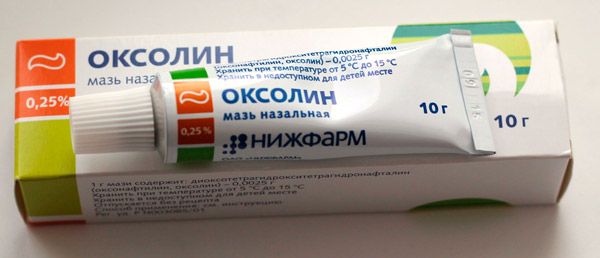
The drug has no toxic properties and does not concentrate in tissues. When applied to the skin, approximately 5% of the drug is absorbed. It is excreted in the urine within 24 hours.
Available in a tube – 30g.
The use of Oxolinic ointment during pregnancy and lactation is permitted.
Contraindicated in case of intolerance to oxoline.
Side effects after using oxolinic ointment are extremely rare. These are isolated cases of allergic dermatitis, and the skin surface may acquire a blue tint from the ointment (it can be easily washed off with water).
Directions for use: lubricate the wart and healthy skin around it with 3% oxolinic ointment until the growth disappears (course of treatment from 2 weeks to 2 months). Can be used on any part of the body. When treating plantar warts, it is recommended to steam the feet and remove necrotic tissue for more effective treatment.
The effectiveness of this ointment has not yet been proven, there are more effective means. Its positive quality is safety due to low absorption and lack of general impact on the body.
Store for no more than three years in the original packaging, maintaining a temperature of no higher than 10ºС, in a dark place. Keep out of reach of children.
Viferon ointment
The active ingredient of the ointment is human interferon alpha-2, an immunomodulator that suppresses the growth of body tissues and the development of viruses in their cells. Among the auxiliary components of the ointment are tocopherol acetate and peach kernel oil, antioxidants that relieve inflammation and restore normal skin balance.
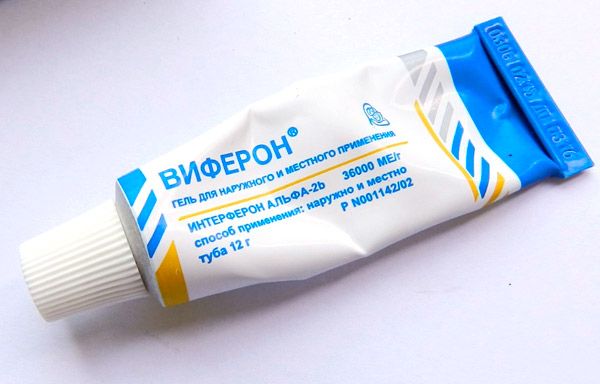
There is virtually no systemic effect on the body due to the low absorption of the ointment when used locally.
Available in a jar of 12g, a tube of 6g and 12g.
The use of Viferon ointment during pregnancy and lactation is permitted.
Contraindicated for infants and in case of intolerance to its ingredients.
There are practically no side effects from using Viferon; in cases of treating mucous membranes, mild runny nose, sneezing, and burning may be observed, which disappear on their own when the drug is discontinued.
The ointment is applied to the wart and the area around it three or four times a day. The duration of treatment is five days (until the effect is achieved).
Viferon ointment can be used simultaneously with any medications used in the treatment of viral infections of the skin and mucous membranes.
Store at a temperature of 2–8ºС in a dark place for one year.
Panavir ointment
The active substance of Panavir gel is potato shoot extract (hexose glycoside), an antagonist of the human papillomavirus.
Hexose glycoside has an immunomodulatory effect, activating the synthesis of interferon. Interrupts the process of biosynthesis of the daughter DNA molecule in infected cells, thereby having a detrimental effect on the development of viruses.
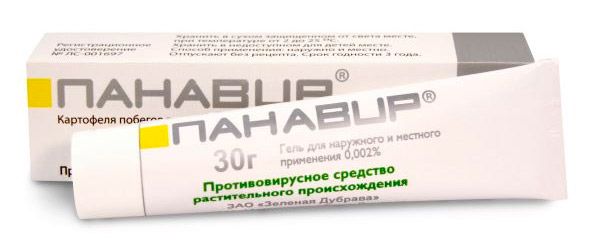
It has the ability to dissolve scars and cicatrices, and is used as part of a complex of treatment measures after surgery to remove warts in order to prevent relapses.
Available in tubes – 3g, 5g, 10g and 30g.
Studies of the drug on laboratory animals have not shown any negative impact on reproduction and fetal development. The use of Panavir during pregnancy is permitted provided that the benefit to the mother outweighs the possible risk of pathologies in the fetus. Since the pharmacokinetics of the gel has not been sufficiently studied, when it is prescribed to a nursing mother, breastfeeding is stopped during the use of this drug.
Contraindications for use are sensitization to the ingredients of the gel and age 0-17 years.
When using Panavir, slight redness and mild itching may occur in the area where the gel is applied.
It is used twice a day for five to ten days. There are no known cases of overdose of this ointment for warts or negative effects from interactions with other medications.
Store for three years at a temperature of 2-25ºС in a dry, dark place out of the reach of children.
Interferon ointment
Contains two active ingredients: human interferon alpha-2 and a complex immunoglobulin preparation, combined on a lanolin base.
The antiviral action of human interferon alpha-2 consists of penetrating into cells and synthesizing a protein there that stops the development of viruses at any stage. Activates the person's own immunity against bacteria, viruses, and protozoa.
The second ingredient is a lyophilisate of protein collodion of immunoglobulins IgG, IgM, IgA, extracted from human blood plasma. In a complex immunoglobulin preparation, the proportion of IgM and IgA is from 15 to 25%, which increases its effectiveness when applied locally.
The interaction of the ointment components provides a good antimicrobial effect inside and outside the cell due to the direct destruction of virulent organisms and activation of the body's own immunity. Due to the significant increase in protein mass in the ointment, interferons maintain resistance to the aggressive environment at the sites of infection.
Available in tubes and jars – 5g, 10g, 30g.
Contraindicated in case of intolerance to the ingredients. Use of interferon ointment during pregnancy and lactation is allowed.
Use once or twice a day for one to two weeks. In case of a large number of pointed condylomas and papillomas, the ointment can be combined with destructive manipulations, using both before and after them to prevent relapses.
The combined use of the ointment with antibiotics and other drugs is acceptable.
Store at a temperature of 4-10ºС in a dark place for no more than one year.
Acyclovir ointment
A monodrug with the same active ingredient, a synthetic analogue of the purine nucleoside deoxyguanidine, a natural element of deoxyribonuclease.
The similarity of acyclovir to its original allows it to interact with viral enzymes, thereby interrupting the process of viral reproduction. In infected cells, it causes a reaction of addition of a phosphoric acid residue and forms acyclovir monophosphate. Guanylate cyclase catalyzes the reaction of converting monophosphate into diphosphate, and several other cellular enzymes into active acyclovir triphosphate, which, integrating into the daughter deoxyribonuclease of the virus, stops the process of its reproduction.
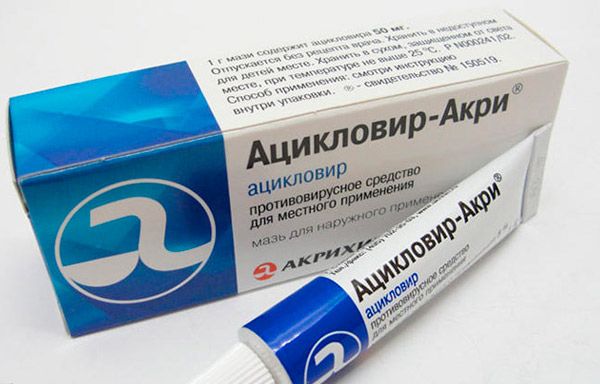
The action of acyclovir is directed selectively at the biosynthesis of viral deoxyribonuclease. Acyclovir does not affect similar processes in human cells.
The ointment applied to healthy skin is not detected in blood and urine, on infected skin - a small absorption is observed. It is excreted by the kidneys (up to 9.4% of the applied amount).
Available in 10g tubes.
Contraindicated in case of intolerance to the ingredients, pregnant and lactating women, children under two years of age.
Causes side effects in the form of irritation and swelling of the skin and mucous membranes, which disappear after stopping the use of the ointment. With prolonged use, the skin may peel.
The application is the same for any age - apply to the infected surface at intervals of 4 hours for five to ten days.
The low absorption of the ointment virtually eliminates the possibility of overdose.
Concomitant use with immunomodulators increases antiviral activity.
The ointment is not used on the mucous membranes of the mouth, nose, eyes, or vagina.
Store at a temperature of 8-15°C in a dry, dark place out of the reach of children for no more than two years.
 [ 17 ], [ 18 ], [ 19 ], [ 20 ]
[ 17 ], [ 18 ], [ 19 ], [ 20 ]
Ointments for removing warts
Salicylic ointment
This ointment is a long-known remedy for removing warts. The active component of the ointment is salicylic acid, which relieves inflammation, disinfects the areas of application, and removes dead skin particles.
Available in a jar – 25g.
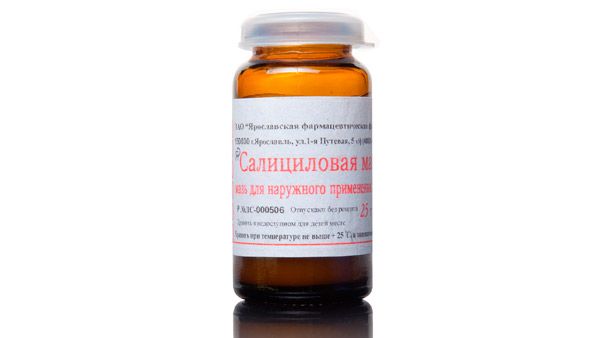
During pregnancy, salicylic ointment can be used to treat small areas of skin in a volume of no more than 5 ml (1 g). Before starting treatment, consult a doctor.
Salicylic ointment is applied to warts once every two or three days in a daily volume of 10 ml (2 g), a sterile bandage is applied to the treated area and secured. Before each treatment, the surface of the warts is freed from necrotic skin particles and disinfected. The ointment is used until the growth completely disappears. Plantar warts are treated after softening them in warm water.
Contraindicated in case of kidney dysfunction, sensitization to aspirin, in infancy. Not used to remove moles, warts located on the face and genitals, warts on which hair grows.
Salicylic ointment may cause skin irritation in the area of application and a slight increase in body temperature.
Salicylic acid, when used together with other external agents, increases their absorption, exacerbates the side effects of methotrexate and antidiabetic agents based on sulfonylurea. The ointment is not recommended for use together with resorcinol (react to form a melting mixture) and zinc oxide (react to form insoluble zinc salicylate).
Store at a temperature not exceeding 20ºС for no more than two years. Keep out of reach of children.
Zinc ointment
The active ingredient of the ointment is zinc oxide, its suspension in Vaseline has antimicrobial, astringent, softening and simultaneously drying properties. Protects the skin surface from adverse effects, reduces exudative manifestations.
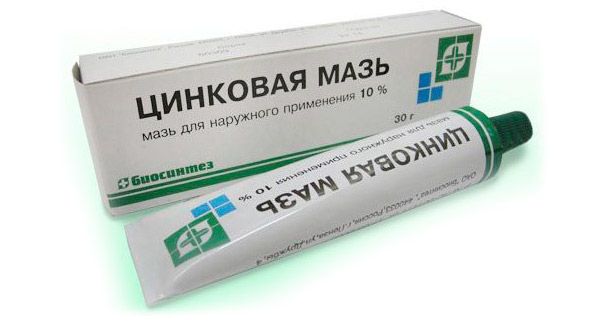
Changes the natural properties of proteins, forming their compounds with zinc. Promotes the process of collagen synthesis, which gives the skin strength and elasticity.
Available in jars and tubes – 20 g.
Use by pregnant and lactating women is completely acceptable.
Contraindicated in case of acute purulent lesions of the skin surface and/or hypersensitivity to the components of the ointment.
Avoid getting the ointment into your eyes; first aid: rinse thoroughly with water.
In cases of long-term use, there may be skin itching, redness, rashes, and isolated cases of allergy are known.
Use two to six times a day, after cleaning the application site. You can apply bandages with ointment. The duration of the course of therapy is individual.
There are no known signs of overdose from using Zinc Ointment.
There are no data on the effects of combined use of the ointment with other drugs.
Zinc ointment is stored for no more than five years in a dark room with a temperature of no more than 15ºС, inaccessible to children.
Celandine ointment
Since time immemorial, celandine juice has been used to remove warts. But this remedy is only available in the summer. At any time of the year, you can use Celandine balm, which has an analgesic, healing, and disinfectant effect. It stops bleeding and inflammation, and the development of benign tumors.
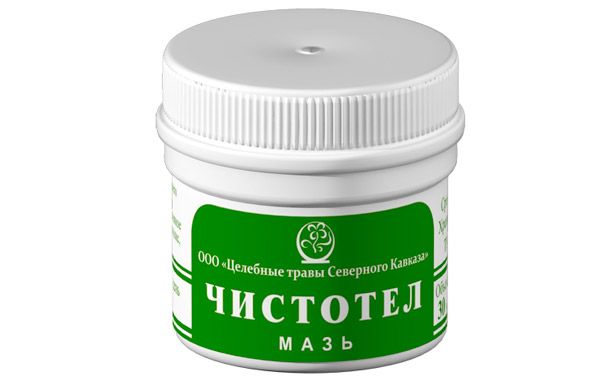
Available in a 20ml tube.
Celandine is toxic, so ointments based on it should not be used during pregnancy and lactation.
In case of hypersensitivity to celandine, the ointment is contraindicated.
The ointment may cause burns.
To remove warts, apply the balm to them once every two to three days, after steaming the warts and treating them with a scraper or pumice stone to remove rough skin.
Store in a cool, dry place for no more than one year.
Vishnevsky ointment
The active ingredients of the ointment are xeroform and tar in equal parts, which have a disinfectant, irritant and anti-inflammatory effect. It has healing properties, stimulating the blood supply process in tissues.
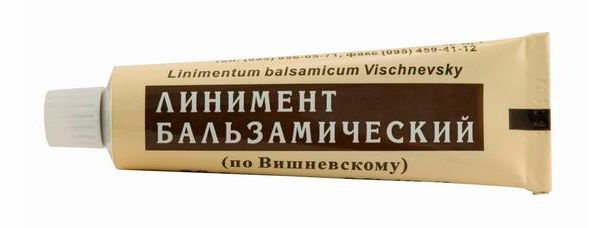
Supplied in jars – 100g, tubes – 40g.
Use during pregnancy and lactation is not recommended.
Contraindicated in case of sensitization to phenol and preparations based on it, as well as to any ingredient of the ointment.
Long-term treatment with Vishnevsky ointment may lead to allergic reactions at the site of application, as well as photosensitivity.
Apply Vishnevsky ointment to the wart two or three times a day. Put a bandage on top, changing the dressings once every two or three days. Continue treatment until the wart disappears.
It is not recommended to allow the ointment to come into contact with mucous membranes; after changing the dressing, it is necessary to wash your hands thoroughly to prevent contact with the mucous membranes.
Overdose may cause allergies.
Combined use with other external agents may lead to negative consequences.
Store for no more than five years, maintaining a temperature of 8-15ºС, in a dark place. Keep out of reach of children.
Ichthyol ointment
The active ingredient is ichthyol (ammonium bituminosulfonate), which has anti-inflammatory, disinfectant and analgesic effects. It does not enter the circulatory system when applied externally.
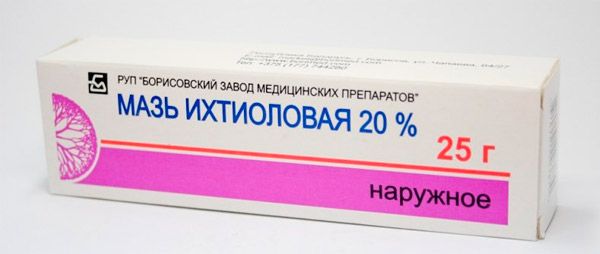
Available in tubes – 30 mg, containers and jars – 25 mg.
During pregnancy, Ichthyol ointment is used only as prescribed by a doctor. Nursing mothers should ensure that the ointment does not get into the child's mouth.
Contraindicated in case of hypersensitivity to the components of the ointment and at the age of 0-11 years.
May occasionally cause allergies.
As a rule, the ointment is applied to the wart two or three times a day, not rubbed in, covered with a gauze bandage. After the procedure, it is recommended to wash your hands well to avoid contact of the ointment with mucous membranes.
The combined use of Ichthyol ointment with other external agents, especially those containing iodine salts, heavy metals, and alkaloids, can lead to negative consequences.
Store for no more than five years at a temperature of 15–20 °C, in a dark room with low humidity.
Betadine ointment
The active substance is povidone-iodine, which has a bactericidal and fungicidal effect. It is active against viruses and protozoa. When it gets on the skin or mucous membranes, iodine is released from the iodoform that binds it and forms iodamines with the proteins of the cells of pathogenic microflora. Thus damaging the cell membranes of pathogenic microorganisms, it helps to destroy them. It has powerful antibacterial activity against gram-positive and gram-negative bacteria (except for the tuberculosis pathogen).
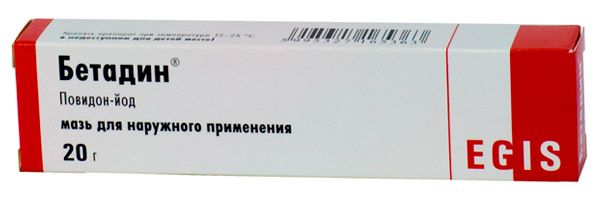
When using the ointment, iodine is practically not absorbed.
Available in tubes – 20g.
Not recommended for use by pregnant and lactating women.
Contraindicated in case of hyperthyroidism and its adenoma;
Duhring's disease; children under 1 year; sensitization to iodine and other components of the ointment. In case of kidney dysfunction - with caution.
May cause allergies.
Use two or three times daily, applying a thin layer to warts.
Frequent use over a large area of skin and mucous membranes may cause systemic reabsorption of iodine and temporary distortion of thyroid function test results.
Do not use together with other antiseptics, especially alkaline, enzymatic and mercury; with radioactive iodine preparations.
Store for no more than three years at a temperature of 15-25°C. Keep out of reach of children.
 [ 21 ]
[ 21 ]
Wart Ointment for Children
New growths in a child must be shown to a doctor, removing them without diagnosis is dangerous. Usually, warts in children go away on their own and it is better not to touch them. However, if they cause discomfort to the child, you can try to get rid of the warts with ointment.
When removing warts at home, you need to follow a few simple rules. Children are not recommended to treat several areas of skin at once. You cannot get rid of warts on a child's face on your own - it is almost impossible to avoid an unsightly scar. You also need to take into account that some time (about two weeks) must pass to remove the wart. You need to be patient and not experiment with different products. However, if no visible changes have occurred within two months, the ointment should be discontinued.
Wart ointment for children should have a gentle effect and the child should not be allergic to its components. When choosing an ointment, you need to carefully read its composition. It is advisable to consult a doctor. Use the ointment only in accordance with the instructions.
To remove warts in children, you can use salicylic ointment. The children's dose of ointment is no more than 1 ml per day. You can treat the skin of children over one year old.
Oxolinic ointment also has a gentle effect and can be used for warts in children over two years old. The treatment will be long-term, up to three months.
Tebrofen ointment is also used to eliminate vulgar warts in children. Also from antiviral ointments for children you can choose Viferon ointment and Interferon ointment.
There are currently many wart removal products available, many of which can be used at home. However, it is recommended to consult a doctor before starting treatment, no matter how harmless the chosen product may seem to you.
Pharmacodynamics
Ointments for warts, depending on their mode of action, are:
- removing the wart, causing necrosis of its tissue, however, not eliminating the cause of its appearance - the human papilloma virus;
- antiviral ointments that stop the reproduction and growth of HPV not only in the superficial cells of the skin, but also in the deeper ones.
 [ 22 ]
[ 22 ]
Dosing and administration
All ointments for warts are applied directly to the neoplasm, antiviral ones are also applied to healthy skin around it 2-4 times a day (as stated in the instructions). Ointments act more gently than liquid cauterizing agents. The use of ointments does not leave scars and marks, with the help of most of them you can remove warts on the face.
For more effective action of the ointment, before removing warts on the soles of the feet, they are first steamed in a bath.
Attention!
To simplify the perception of information, this instruction for use of the drug "Ointments for warts" translated and presented in a special form on the basis of the official instructions for medical use of the drug. Before use read the annotation that came directly to medicines.
Description provided for informational purposes and is not a guide to self-healing. The need for this drug, the purpose of the treatment regimen, methods and dose of the drug is determined solely by the attending physician. Self-medication is dangerous for your health.

